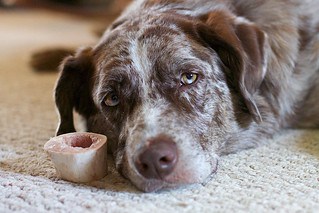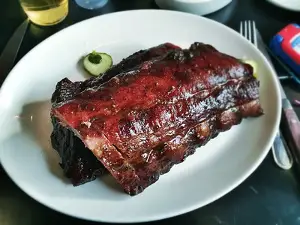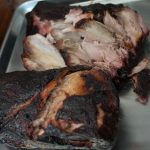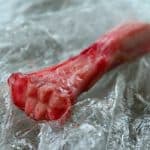
A dog gnawing on a bone, furiously guarding it or digging a hole to hide it. We all grew up with this image so throwing a dog a bone seems the most natural thing in the world.
However, in an era where people buy pet food at the store, many dog owners shudder at the idea of feeding their four-legged friends bones of any kind. Who is right and who’s wrong?
Are bones bad for dogs? What about cartilage? Can a dog eat cartilage at least?
Here are the answers to all your questions.
What is cartilage? And why is it beneficial for dogs to eat it?
Cartilage is the chewy part at the end of a bone. In scientific terms, it’s the connective tissue holding bones together in a joint – shoulders, knees, or even the end of the ribs. In terms of texture, it’s firm and rubbery – naturally, as its biological function is to absorb the shock caused by movement.
Is it good for dogs to eat cartilage? Definitely yes and here is why.
Cartilage contains a lot of glucosamine. You might have heard of glucosamine as a supplement recommended for people with arthritis. Well, dogs get arthritis, too as they age. There are, in fact, glucosamine supplements for dogs. It only makes sense to include cartilage in your dog’s diet to make sure he gets the glucosamine he needs to keep his joints in good health.
The best sources of natural glucosamine for your dog are chicken feet, beef trachea, or pigtails.
For instance, chicken feet are 30% cartilage. This cartilage contains 5% glucosamine. Experts say just one chicken bone will provide your dog with some 450 mg of glucosamine.
Beef trachea is even better – it has the same amount of glucosamine but it is bigger so your dog might get around 1,400 mg of glucosamine from one serving. That’s quite a lot considering that a vet would generally prescribe 1,000 mg of glucosamine supplement for a dog with arthritis.
Cartilage is good for your dog’s bones and also helps with his dental hygiene. Chewing on rubbery cartilage cleans your dog’s teeth, as it removes nasty bacteria and little bits of food stuck between his teeth. This will also prevent gum disease.
Giving your dog cartilage is good, the question is how to do it safely, as gnawing bones poses a significant number of risks.
Should dogs eat raw or cooked bones?
Very tough questions and the answer will surely annoy those who think it’s nice to give a dog a bone from the dinner table. Obviously, the dog will appreciate the treat and love you for that, but the truth is that cooked bones can be quite dangerous to a dog.
More and more pet owners are embracing the BARF diet which advocates feeding a dog raw food, as nature intended. Their wolf ancestors relied on hunting for food, not the pet store so raw food cannot be bad for the modern dog either.
The controversy around raw or cooked bones has nothing to do with wolves or tradition. Call it science or simple observation, but the fact is that cooked bones are dangerous because they are brittle and can break or splinter easily, causing a lot of problems to your pet.
- Pieces of bone and splinters can break a tooth or scratch the dog’s mouth. At the same time, the bone fragment might get looped around the lower jaw, getting basically stuck there. This will cause a lot of pain to your dog, while you might have to pay for oral surgery.
- Bone fragments can get lodged in the esophagus or the trachea, making your dog choke.
- Some bone splinters can be pretty sharp and perforate the stomach or the lower intestine which can lead to peritonitis, an infection caused by the stomach content spilling into the abdomen. This will require urgent medical attention as it can be fatal.
- If a bone fragment gets stuck in the stomach, the dog might need surgery to have it removed.
- All these problems might also cause your dog rectal bleeding.
- Vets say that the commercially available bone treats are also not safe for dogs because they are usually smoked or baked, which makes them brittle.
A lot of people believe a better alternative is to grind bones and mix them with the dog’s regular food, as a source of calcium and other minerals. The problem with this approach is that it doesn’t help with the dog’s oral health as chewing does.
What type of animal bones should dogs eat?
Raw bones are good for your dog as they provide valuable minerals, stimulate saliva, clean the teeth and, of course, satisfy the dog’s natural instinct to chew.
The best bones for your dog are chicken bones, but any other type of poultry will do. Quail and turkey bones are a good alternative, as are rabbit or lamb bones. You can even feed your dog kangaroo bones if you live in Australia that is.
Many people wonder if it’s OK to give a dog beef bones and the answer is yes. Large beef bones are good as recreational bones, something to give your pet to keep him entertained for a while.
There’s fierce debate around pork. Can you feed a dog pork? The answer is yes. If you’re ready to feed your dog chicken bones, pork is just as safe.
What type of bones should dogs eat?
Small flexible bones are good for your dog to chew and digest. Chicken wings are the preferred option for many pet owners, and it is unlikely your dog will have problems with that. Chicken legs are also deemed safe for a dog. You can also feed a dog chicken carcass which is rich in glucosamine and has an odd shape that will keep the dog busy for a long time!
You can also feed your dog beef brisket bones, which is the breast bone of the cow, and cow trachea which is mostly made of cartilage.
As far as lamb is concerned the best bits for your dog are rib flaps and the necks.
Some pork bones can be too thick or hard for your dog to chew. Try feeding your dog smaller pork bones and if he has no problem devouring them, you can try giving the dog bigger bones.
Ribs can be dangerous to a large dog who might crack the bone easily and try to swallow the pieces. Ribs are safe for small dogs who will take a lot of time to chew on them.
How long do beef bones last in the fridge?
Large beef bones are a nice treat for a dog as it gives him something to chew on. The general advice is to give a dog a bone after his meal – to gnaw at it rather than eat it. Allow the dog to have some fun with it for 20 minutes or so then take it away before things become too interesting and the dog is hell-bent on eating the bone.
If you manage to wrestle the bone from the dog, put it in the fridge. You can keep it in the fridge for two or three days, assuming you have a good fridge. If you find that the bone starts smelling funny, do not give it to the dog anymore.
If you’re using the bone as an occasional treat you can put it in the freezer for a couple of days and then present it again to your pet.
Some go as far as to say that once the dog has consumed all the meat and the cartilage on a large bone it’s not useful anymore and you should take it away and throw it.
Do bones wear down a dog’s teeth?
Depends on who you ask. While many pet owners who have their dogs on the raw BARF diet say they’ve never had this problem, some go as far as to say it wears them down too much. Naturally, this is the sort of argument you’re likely to hear from those who are against feeding bones to a dog in general. They will try to use any argument against this, including the risk of the dog’s breaking a tooth on a hard bone.
However, feeding a dog flexible chicken bones is unlikely to cause significant wear and tear. Nor will occasionally gnawing at a large bone. Especially a large dog, who is the same size as a wolf. In cases like this, always trust nature. No matter what some might say dogs were not meant to eat kibble. It’s very convenient for a pet owner to use store-bought food, but every dog has a wolf in his family tree.
Tips on feeding your dog bones
- Never offer a dog a bone when in company, canine company, as this might trigger a fierce fight among the dogs.
- Never leave a dog unsupervised with a bone. You never know when the dog might break the bone and you don’t want him to choke on a piece.
- Large dogs like Mastiffs or German Shepherds should be presented with large bones that pose some problems. There’s always the risk that a large dog might try to swallow a small bone whole and it can get lodged in the esophagus.
- Be very careful when feeding bones to dogs with flat faces and short snouts, like bulldogs and boxers. They might have a hard time wrestling with a bone.
- To avoid the risk of a dog trying to swallow the entire bone the rule of thumb is that the bone should always be longer than the dog’s muzzle.
Wrapping Up
Bones and cartilage are good for a dog if you know what types of bones it’s OK to give to your pet. Even if you’re not convinced of the benefits of the raw BARF diet, the occasional bone is an excellent source of minerals, including calcium, not to mention the glucosamine in the cartilage. However, keep in mind that cooked bones are too brittle and can be dangerous.
Last, but not least, having a bone to chew on is good for your dog’s mental health. Chewing is an instinct and dogs need to satisfy this animal need. And if you give a dog a bone he won’t have any excuse to chew on your slippers!
Photo Credits
¹ Photo by Alan Levine





